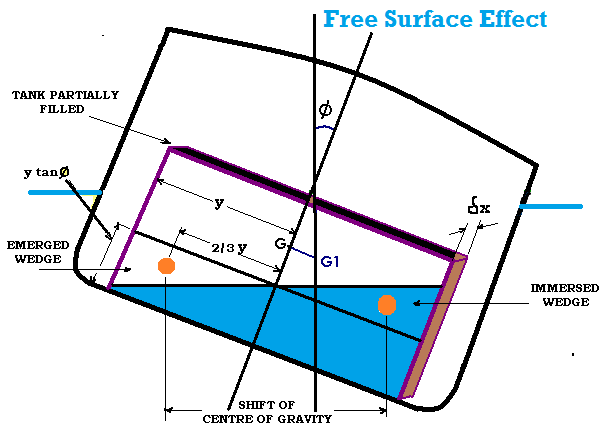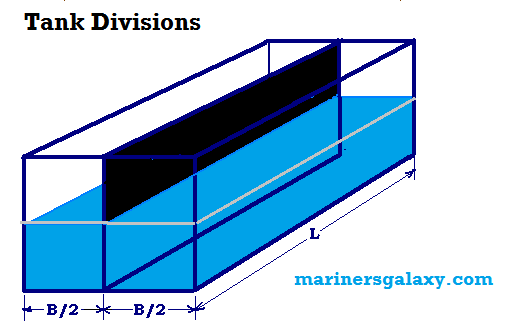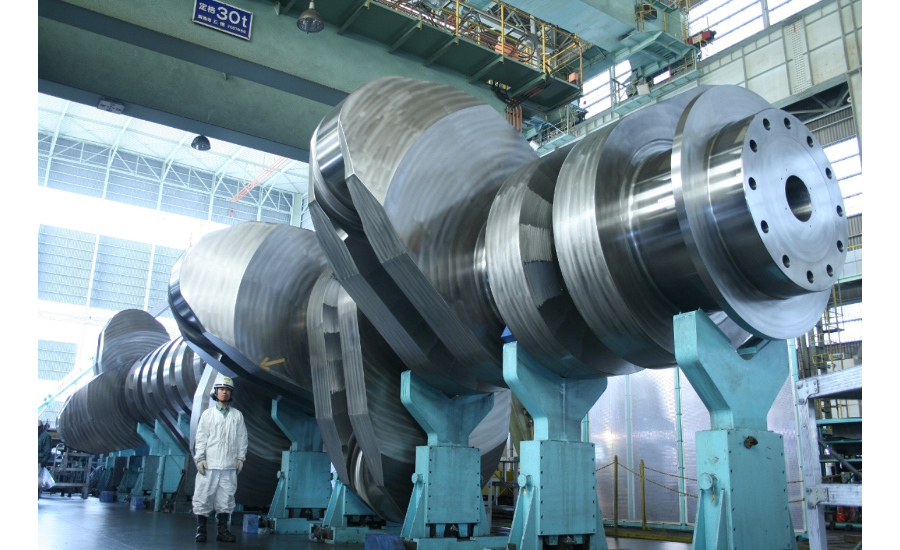Read about free surface effect in vessels and the methods that are used to reduce the same. If, free surface effect is not corrected, then it posses great threat to the stability of the ship. Tanker ships mostly have problem with this type of effect.
Let’s see what it is and how we tackle in real scenarios.
Concept of Free Surface Effect
When a tank on the ship’s centreline is not completely full of liquid, and the ship heels, the liquid in the tank moves across the tank in the same direction as the direction of heel. Because of this effect, the centre of gravity of the ship moves away from the centreline, which reduces the righting lever ‘GZ’ & the height of the metacentre, which further increases the angle of heel. This effect is known as the free surface effect.
Let us consider a tank partly full of water in a ship of displacement ‘∆’, and inclined to some angle ‘ǿ’. The ship’s centre of gravity will move from ‘G’ to ‘G1’, as the wedge of liquid moves across the tank.
As per our knowledge, see the diagram.
Moment of shift of ship’s buoyancy = moment due to shift of buoyancy wedge.
∆ x GG1 = m x gg1
m x gg1
GG1 = …………………..
∆
v x ρ x gg1
GG1 = ………………..= which is shift of C.G. ……..(1)
▼ x ρ1
Meaning of terms:
v = Volume of wedge, ρ = Density of wedge, ρ1 = Density of sea water
▼= Volume of displacement. m = Mass of wedge
Now as the wedge of liquid is triangular and it is assumed to be divided in to thin strips of length ‘δx’.
Volume of strip of wedge = ½ x y x ytanǾ x δx
= ½ y2 tanǾ x δx Mass of strip of wedge = ρ x ½ y2 tanǾ x δx Moment of transfer of strip of wedge
= (4/3y) x ρ x ½ y2 tanǾ x δx
= ρ tanǾ x 2/3 y3 δx
Moment of transfer of total wedge
=
ρ tanǾ x Σ (2/3 y3 δx) …………………………….. (2)
Also, moment of transfer of total wedge will be
= v x ρ x gg1 …………………………….. (3) We will get from equations (2) AND (3)
v x ρ x gg1 = ρ tanǾ x Σ (2/3 y3 δx) ……………………………..
(4) Now as the wedge of liquid is triangular and it is assumed to be divided in to thin strips of length ‘δx’.
Volume of strip of wedge = ½ x y x ytanǾ x δx
=
½ y2 tanǾ x δx
Mass of strip of wedge = ρ x ½ y2 tanǾ x δx
Moment of transfer of strip of wedge
= (4/3y) x ρ x ½ y2 tanǾ x δx
= ρ tanǾ x 2/3 y3 δx Moment of transfer of total wedge
= ρ tanǾ
x Σ (2/3 y3 δx) …………………………….. (2)
Also, moment of transfer of total wedge
= v x ρ x gg1 …………………………….. (3) We will get from equations 2 and 3
v x ρ x gg1
= ρ tanǾ x Σ (2/3 y3 δx) ……………………………..(4)
But as we know that,
Σ (2/3 y3 δx) = 2nd moment of area of free surface about the centerline of the tank
= Ixx = (1/12 x l x b) ……………………………..
(5) We will get from equations (3) and
(5), v x ρ x gg1 = ρ tanǾ x Ixx …………………………….. (6)
from (1) and (6)
ρ tanǾ x Ixx
GG1
= ……………………………..= shift of C.G. …………………………….. (7)
▼ x ρ1
As a result of this movement (shift) of the ship’s centre of gravity from g to G1, the righting lever ‘GZ’ is reduced to ‘G1Z’
Reduction in righting lever due to free surface effect will be = G1Z = G2Z = G2M sinǾ
Now from triangle ‘GG1G’2
GG1
——
= tanǾ
GG2
GG2 = which is reduction in metacentric height
GG1
= ……………………………8)
tanǾ Therefore from (7) and (8)
ρ tanǾ x Ixx 1
GG2
= ……………… x ………………
▼ x ρ1 tanǾ
And there will be reduction in gm due to this free surface effect
ρ x Ixx
=
GG2 = ……………… (9)
▼ x ρ1
Methods to Reduce the Free Surface Effect
1) Use of tank divisions
In tankers ships this is the first method. The effect of free surface of liquid may be most dangerous in a vessel with small metacentric height and may even cause the vessel to become unstable. In such ships, the tanks which are required to carry liquid should be pressed up tight. If the ship was initially unstable and heeling to port or starboard side, then caution needs to be taken as any attempt to fill water ballast will reduce the stability further and thus effecting the stability. Therefore before ballasting, an attempt should be made to lower the centre of gravity of the ship by pressing up the existing tanks and lowering the masses of the ship.Let’s consider a rectangular
tank of length ‘l’ and breadth ‘b’ partly full of liquid as shown in figure.
From equation no. (1), (2) and (3) it is observed that free surface effect goes on reducing by introduction of longitudinal plate divisions forming equal size tanks.
The ship with the greatest free surface effect is the oil tanker, since space must be left in the tanks for expansion of oil. Originally
tankers were built with centerline bulkhead and the expansion tanks. Twin longitudinal bulkhead were then introduced without expansion tanks and were found to be successful, since design takes care of the loss in metacentric height due to free surface effect. It is not possible to design the dry cargo vessel in the same way, since the position of the centre of gravity of the ship varies considerably with nature of disposition of the cargo.
They restrict the motion of the water in the tank, thus reducing the free surface effect.
They divert the motion of the water, and this will result much lo nger time for water to reach other end.
As such they will they are not directly controlling the free surface effect, they are reducing the rolling, and hence the extant of rolling. This was from this article What is Free Surface Effect and How to reduce it.





